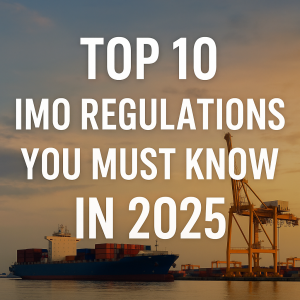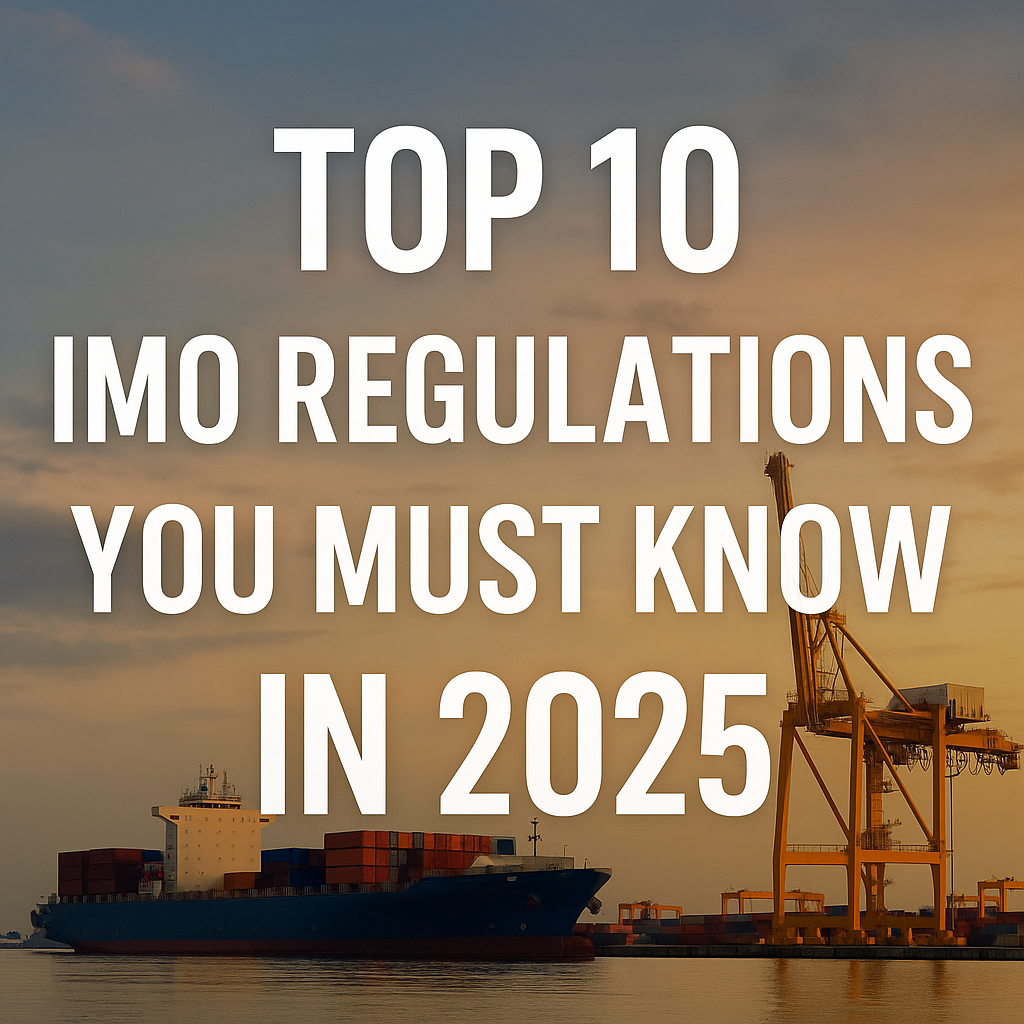Discover the top 10 IMO regulations transforming maritime operations in 2025. Stay compliant, reduce emissions, and future-proof your fleet with this expert guide.
Why IMO Regulations Matter in Modern Maritime Operations
In today’s rapidly evolving shipping industry, staying ahead of regulatory changes isn’t just good practice—it’s essential for survival. The International Maritime Organization (IMO), the United Nations agency responsible for the safety, security, and environmental performance of international shipping, continues to roll out transformative regulations that affect how ships are built, operated, maintained, and recycled.
In 2025, several key regulations will come into force or gain stronger enforcement, aimed at reducing carbon emissions, enhancing crew safety, improving waste management, and promoting cleaner oceans. For shipowners, operators, maritime educators, and cadets, understanding these top 10 IMO regulations is crucial for navigating compliance and optimizing vessel operations.

1. Carbon Intensity Indicator (CII) Enforcement Intensifies
Effective Date: Phase-in began in 2023, stricter evaluation in 2025
CII measures the CO₂ emissions per transport work (grams CO₂ per DWT-mile) of ships over 5,000 GT. Starting 2025, ships with poor ratings (D or E) for three consecutive years will face mandatory corrective action plans submitted to their flag states or classification societies.
Real-World Impact: According to DNV, over 40% of the global fleet may receive D/E ratings in 2025 unless operational profiles are improved or energy-saving devices are installed.
Related Regulation: IMO Resolution MEPC.328(76)
2. EEXI (Energy Efficiency Existing Ship Index) Compliance Audits
Applies To: Ships >400 GT in international trade
By 2025, Port State Control authorities under the Paris MoU and Tokyo MoU are expected to increase EEXI compliance checks. Non-compliant ships may be delayed or denied entry. EEXI requires older ships to demonstrate energy efficiency similar to new vessels by limiting engine power or retrofitting energy-saving technologies.
Case Study: A 2010-built Panamax bulk carrier reduced shaft power using an Engine Power Limitation (EPL) device to meet EEXI without expensive retrofits.
3. Mandatory Maritime Cyber Risk Management in SMS
Enforcement Date: Ongoing since January 2021; focus increases in 2025
As digital systems grow in complexity, cyberattacks on ships and port infrastructure pose real threats. In 2025, Port State Control inspections will focus more on documented cyber risk protocols in a ship’s Safety Management System (SMS), as per IMO Resolution MSC.428(98).
Example: The Maersk cyberattack in 2017 cost nearly $300 million—highlighting the stakes of unpreparedness.
Guidance Document: IMO Guidelines on Maritime Cyber Risk Management
4. Ballast Water Management System (BWMS) Compliance Deadline
Key Regulation: IMO BWM Convention (2004), full compliance deadline 2024–2025
As of 2025, all ships must comply with the D-2 standard for ballast water discharge. This means having an IMO- and USCG-approved ballast water treatment system installed and operational. Non-compliance can lead to detention and denial of port entry.
Stat: According to Lloyd’s Register, over 80,000 vessels were affected by the convention rollout, requiring multi-billion-dollar investments in retrofitting.
5. IHM (Inventory of Hazardous Materials) Port Inspections
Linked To: EU Ship Recycling Regulation, IMO Hong Kong Convention
Increased enforcement by EU port authorities in 2025 will ensure non-EU flagged ships visiting EU ports carry a certified IHM report onboard. The regulation tracks materials like asbestos and PCBs to ensure safe recycling and reduce environmental contamination.
Note: Class societies like DNV and ABS now offer IHM certification services integrated with planned maintenance systems.
6. SEEMP Part III Verification (Ship Energy Efficiency Management Plan)
Applies To: Ships >5,000 GT
2025 marks the year SEEMP Part III becomes fully auditable under MARPOL Annex VI. Ships must document operational measures taken to improve energy performance, such as voyage optimization, hull cleaning intervals, and slow steaming.
Real-World Example: A bulk carrier operating in the Indian Ocean implemented weather routing and reduced fuel consumption by 8%, satisfying SEEMP targets.
7. Biofouling Management Guidelines Update
New in 2025: Revised voluntary guidelines becoming semi-mandatory through regional adoption
The updated guidelines promote proactive hull cleaning to reduce invasive species and improve fuel efficiency. Regions like Australia, New Zealand, and California are already enforcing local biofouling rules, expected to influence IMO to make stricter rules in 2025.
Reference: IMO Biofouling Guidelines
8. Fire Safety Regulations for Ro-Ro and Passenger Ships
Effective Date: January 1, 2025
New SOLAS amendments introduce stricter measures for fire detection and suppression systems on Ro-Ro passenger vessels, including fixed water-based firefighting systems and enhanced insulation for electrical vehicle transport.
Motivation: Rise in EV fires onboard ferries and car carriers prompted this regulatory update.
Implemented By: IMO Maritime Safety Committee (MSC 105)
9. Remote Surveys and Digital Certificates
Trend for 2025: IMO supports widespread digitalization
IMO encourages flag states and class societies to accept digital certificates and enable remote inspections via high-res cameras, drones, and satellite communications. This boosts safety and efficiency while cutting survey costs.
Development: As per IACS (International Association of Classification Societies), over 40% of class surveys were partially remote by the end of 2024.
10. Mandatory GHG Reduction Measures (Phase 3)
Context: MARPOL Annex VI amendments
Following the revised IMO GHG Strategy adopted in 2023, 2025 will introduce stricter carbon caps on shipping operations. Discussions around carbon pricing, lifecycle emissions accounting (LCA), and well-to-wake analysis are shaping future enforcement.
Insight: The shift to alternative fuels like green methanol, ammonia, and LNG will accelerate in 2025, guided by this roadmap.
–
Case Studies & Real-World Applications
Case Study: Aframax Tanker Upgrades for EEXI and CII
A mid-size tanker installed shaft power limitation and voyage optimization software in early 2024 to prepare for 2025 audits. Result: A 12% drop in fuel consumption and a CII rating improvement from D to C.
Case Study: Large Container Vessel Retrofitted for SEEMP III
A Singapore-flagged ship added solar-assisted battery packs to support auxiliary systems, helping it meet SEEMP III KPIs and reduce port idle emissions.
Frequently Asked Questions (FAQ)
1. What is the most important IMO regulation in 2025?
Arguably the CII regulation, as it affects a vast portion of the global fleet and requires measurable operational changes.
2. Are these regulations the same for all vessel types?
While the core regulations are standardized, enforcement and compliance measures vary by ship size, type, and flag.
3. What happens if my ship fails to comply with CII or EEXI?
Your vessel may face detention, port delays, or financial penalties. Classification society audits could also flag your vessel as high-risk.
4. How can ships meet SEEMP III requirements?
By implementing voyage optimization tools, regular hull cleaning, trim adjustment, and crew training on energy-saving operations.
5. Is IMO making regulations more technology-friendly?
Yes. With initiatives supporting digital certificates and remote surveys, IMO is actively embracing maritime digitalization.
6. Are these regulations legally binding?
Yes, once ratified by IMO member states and entered into force via MARPOL or SOLAS amendments, they carry legal weight.
Conclusion
As 2025 unfolds, IMO regulations are not just shaping ship design—they are redefining how the maritime industry operates, reports, and innovates. From environmental compliance to digital transformation and crew safety, these rules create a roadmap for a safer and greener shipping future.
Maritime professionals, educators, and cadets must proactively understand and implement these regulations—not only to stay compliant but to contribute to a more sustainable global fleet. As the regulatory tide rises, being informed is not optional—it’s your anchor.
References
-
International Maritime Organization (IMO). https://www.imo.org
-
DNV. (2024). CII and EEXI Technical Guidance. https://www.dnv.com
-
Lloyd’s Register. (2023). Future Fuels and Regulatory Outlook. https://www.lr.org
-
IHS Markit / S&P Global. (2024). Shipping Compliance Intelligence.
-
The Nautical Institute. (2023). Guide to SEEMP III. https://www.nautinst.org
-
Paris MoU. Port State Control Annual Report. https://www.parismou.org
-
ABS. (2024). Cyber Risk in Maritime Operations. https://www.eagle.org
-
The Royal Institution of Naval Architects (RINA). Journal of Maritime Safety and Law.


Hello! Someone in my Myspace group shared this website with us so I came to look it over.
I’m definitely loving the information. I’m book-marking and will be tweeting this
to my followers! Terrific blog and terrific style and
design.
I enjoy what you guys are usually up too. This type of clever work and coverage!
Keep up the very good works guys I’ve added you guys to
our blogroll.